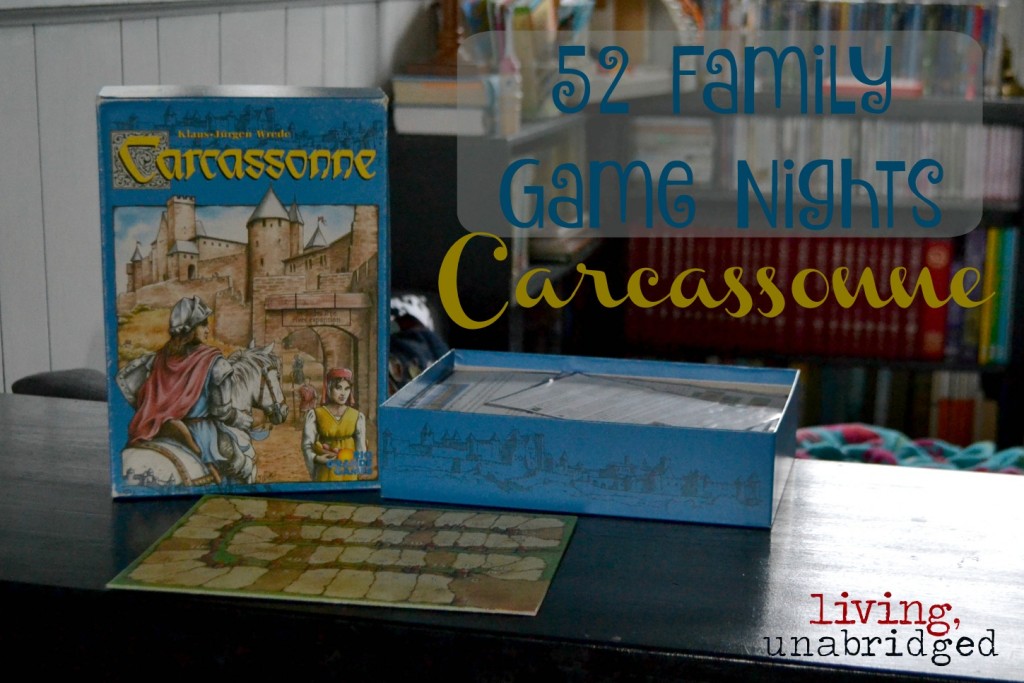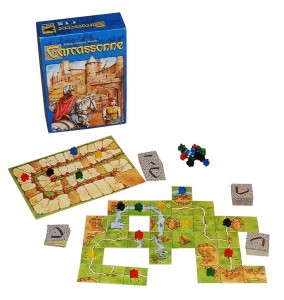Last week we shared a tile laying game suitable for younger children. This week we're sharing Carcassonne, a tile laying game not just for children. This is one of the first tile laying games I remember seeing when my husband started bringing home Euro-games.
 Family Game Night #12: Carcassonne
Family Game Night #12: Carcassonne
As has become fairly common for this series, I've asked our family game expert to explain the appeal and how to play:
Carcassonne makes the short list for classic German games you must try. Named after a famous tourist city in France, this tile-laying game can be enjoyed by the whole family in under an hour. This game also helped to popularize the now ubiquitous “meeple” even though the term never appears in the rule booklet. These cute little people-shaped chunks of wood combine with the beautifully illustrated tiles for a pleasant gaming experience.
The base game begins with a single tile (there are many, many expansion packs). The rest of the tiles are shuffled into stacks and placed around the play area. On your turn, you simply reveal a tile and place it next to any played tile so that all the sides match up correctly. Then you have the option of placing one of your meeples on that tile.
The tiles contain different landmarks that each score differently. You can place in a city and get 2 points for each section in it once completed. Or you can place on a road and get 1 point for each section once it’s completed. Some tiles have a monastery; placing here gives you 9 points if all the surrounding tiles get placed. Finally, you can place on the fields and score 3 points per adjacent completed city.
The trick is that you only have a few meeples, and you don’t get them back until a feature is completed. In the case of fields, they will not be scored until the end of the game. If you don’t have any to place, you can miss out.
The other trick is that you can’t claim a feature that already contains a meeple. There are some clever ways around this, but it does make things challenging. That’s pretty much the whole game. When the last tile is played, all the remaining meeples are scored. The highest score wins.
The most difficult rule is the one about how the fields are scored. When playing with younger players, you might just leave that off entirely. As I mentioned, there are numerous expansions to this game. One of our favorites is The Princess and the Dragon. This adds a hungry dragon to the game that occasionally eats some of the meeples before they can score. It can be a little frustrating sometimes, but mostly it’s just fun trying to avoid the dragon. There is also a fairy to help protect you and a vindictive princess that kicks people out of cities. Whether you have lots of expansions or just the base game, Carcassonne is certainly worth your time.
 Much like Settlers of Catan, this is considered a "gateway game" to the larger world of Euro-games. If you are ready to venture out of the familiar American board game scene (Monopoly, Life, etc.) Carcassonne makes a great first step. The classic game can be found for around $35, but there are newer versions and loads of expansions. If your family ends up enjoying the game, adding a new expansion at a holiday or birthday is a great way to add some variety to the familiar. (The newer edition is $25 from Amazon right now, but I cannot tell you if it is exactly the same because we don't own it.)
Much like Settlers of Catan, this is considered a "gateway game" to the larger world of Euro-games. If you are ready to venture out of the familiar American board game scene (Monopoly, Life, etc.) Carcassonne makes a great first step. The classic game can be found for around $35, but there are newer versions and loads of expansions. If your family ends up enjoying the game, adding a new expansion at a holiday or birthday is a great way to add some variety to the familiar. (The newer edition is $25 from Amazon right now, but I cannot tell you if it is exactly the same because we don't own it.)
Summary of Carcassonne:
Number of Players: 2-5
Recommended Ages: 8 and up, but we've played with younger (sometimes with altered rules as Philip described)
Reading Required: No, for players. Yes, for someone to read the rules. {wink}
Has your family played Carcassonne? Do you have a favorite expansion or twist to the rules?
Follow Karen (Living Unabridged)'s board Family Game Nights on Pinterest.







